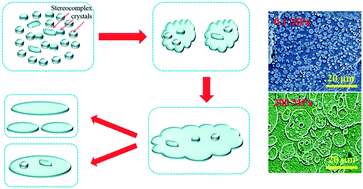Pressure-controlled crystallization of stereocomplex crystals in enantiomeric polylactides with remarkably enhanced hydrolytic degradation†
Abstract
One key bottleneck in extending the use of stereocomplexed polylactides (sc-PLA) as functional biomaterials is the conflict between the high stereocomplex degree and controllable degradation rate. Herein, we report for the first time the pressure-controlled primary molecular assembly and subsequent secondary self-organization of the resultant stereocomplex crystals in ternary enantiomeric polylactides. The stereocomplex formation efficiency as well as the size, morphology and distribution of self-organized crystalline stereocomplex architectures was effectively tuned with the variation of crystallization temperature, pressure, time, and compounding ratio. In particular, the large scale growth of the size distributed sc crystals, with unique micro/nanoscale hierarchical topological structures, allowed for the easier penetration of water in amorphous regions and the consequent accelerated hydrolytic scission of PLA chains, irrespective of the hydrolysis media, whereas at the same time maintained the thermal stability of the polymer. This finally led to the design and fabrication of sc-PLA with the coordinated properties of improved heat resistance, enhanced hydrolytic degradation and moderate hydrophilicity. The study presented here may offer a promising approach to the construction of stereocomplexed enantiomeric biopolymers with optimized combinatorial functions in biomedical applications.



 Please wait while we load your content...
Please wait while we load your content...